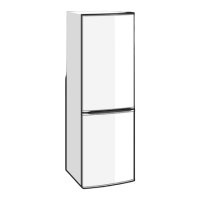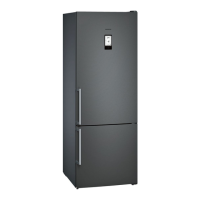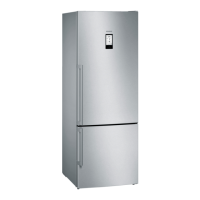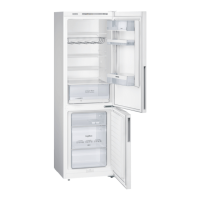en
22
Freezing and storing
food
Purchasing frozen food
■ The packaging must not be damaged.
■ Pay attention to the expiration date.
■ The temperature in the supermarket
freezer must be -18°C or lower.
■ If possible, transport frozen food in an
insulated bag and place quickly in the
freezer compartment.
When loading items, please
note:
■ Freeze larger quantities of food
preferably in the bottom frozen food
container. This is where food freezes
particularly quickly and the process is
therefore particularly gentle to the
food.
■ Distribute the food over the whole
area of the compartments
or the frozen food containers.
Note
Food which is already frozen must not
come into contact with the food which
is to be frozen. If necessary, re-stack
frozen food in the frozen food
containers.
■ To ensure air circulation in the
appliance, push the frozen food
container all the way in.
Freezing small amounts of
food
How you freeze smaller amounts of food,
so that they are frozen solid extremely
quickly, can be found in the section
"Automatic super freezing".
Freezing fresh food
Freeze fresh and undamaged food only.
To retain the best possible nutritional
value, flavour and colour, vegetables
should be blanched before freezing.
Aubergines, peppers, courgette and
asparagus do not require blanching.
Literature on freezing and blanching can
be found in bookshops.
Note
Keep food which is to be frozen away
from food which is already frozen.
■ The following foods are suitable for
freezing:
Baked goods, fish and seafood, meat,
game, poultry, vegetables, fruit, herbs,
eggs without shells, dairy products
such as cheese, butter and quark,
ready meals and leftovers such
as soups, stews, cooked meat and
fish, potato dishes, casseroles and
desserts.
■ The following foods are not suitable
for freezing:
Types of vegetables, which are usually
consumed raw, such as lettuce or
radishes, eggs in shells, grapes,
whole apples, pears and peaches,
hard-boiled eggs, yoghurt, soured
milk, sour cream, crème fraîche and
mayonnaise.
Packing frozen food
To prevent food from losing its flavour
or drying out, pack airtight.
1. Place food in packaging.
2. Squeeze out the air.
3. Seal the packaging tightly.
4. Label packaging with contents
and date of freezing.

